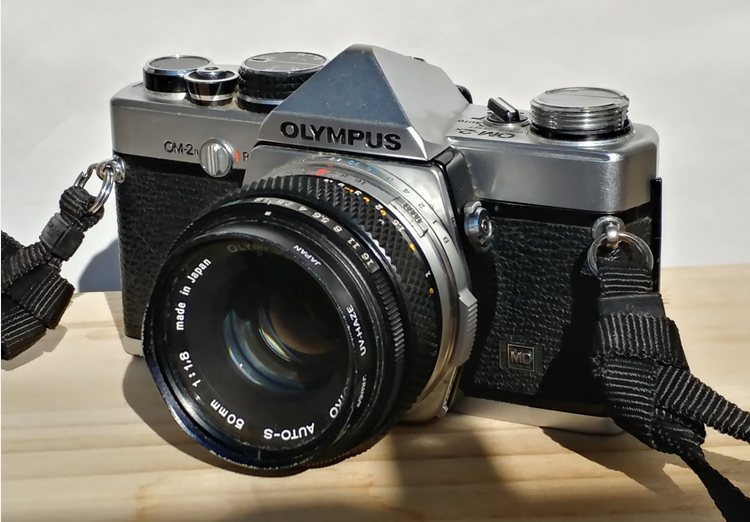
Features
Lens mount: OM Bayonet
Lens (kit): Zuiko Auto-S 50mm f/1.8
Shutter: Focal plane, 1~1/1000 + B
Meter: Dual Blue CdS, OTF in aperture priority mode
Viewfinder: Horizontal split-image focus dot
ISO: 12~1600
Battery: LR44 x2
Focal range: 3.3′ to infinity
Detachable Hotshoe
Weight: 520g (body)
Production: 1975~1984
Sold for $515 (1979), $1,511 (2019)
Purchased for $54 (2019)
An intro to film
It's 2020 and there's nothing to a phone camera. It's as utilitarian as eating out of pots and pans with your hands. The resulting outcome is identical but the process is ungrateful, it strips eating down to a caloric addition, a transfer of mass inside of you.
There's something alluring about something so tactile and physical as a film camera. Images are stored horizontally on a laminated plastic sheet impregnated with dyes and silver halide crystals. Dials adjust how much light is shined on the film plane through aperture and shutter speeds, and a lever advances the film for a new exposure. A chemical wash performed in a darkroom reacts with the crystals, preserving the image. The physicality of cogs and levers paired with the alchemy of chemical emulsions makes shooting film an interesting diversion from the sterility of modern photography. Photos are preserved on a physical medium you can feel and see, not as an intangible file. Color reversal films in particular feel almost magical, being able to see what you captured without color manipulation. Controls are tactile and satisfying, there are few digital cameras that manage to escape the jaws of dizzing menus and oddly placed function buttons. Even through all the improvements to autofocus and image stabilization, digital photography's lineage from film has always been fairly explicit. The fundamentals of exposure: ISO, shutter speed, and aperture are still identical. Many digital camera lines directly trace their lineage from film cameras: Canon EOS, Nikon F, Olympus PEN and OM, Ricoh GR, Sony α, etc. The mile-long naming schemes in today's cameras are a direct consequence of their inheritances from film photography.
It stand as palate cleanser to the specs-based comparisons of digital cameras or the horrid subjectivitsm of more fluffy hobbies. It's great. Photography never really appealed to be due to the high upfront cost, but film is a great way to learn the fundamentals in an incredibly hands-on way.
History

Nikon was already dominating the professional SLR market with their F series in the 70's. They were big, heavy, modular cameras that often prioritized durability over versatility. Olympus' OM system aimed to carve out a section of this existing market with compact, lightweight system components and advanced metering. The OM-2 added improved dual metering via blue silicon cells and an option for aperture-priority mode, while retaining the tiny form factor of the original OM-1. The lenses offered are still unrivaled in size and weight, with the kit f/1.8 50mm lens measuring only 4cm long. With the arms race to shrink body sizes kicked off by Olympus, the rapid development of semiconductors in the 80's would really accelerate this trend in the market. Later cameras like the Pentax ME Super would surpass the OM1/2 in size and weight, and even Nikon famous for their "a generation-behind" offerings would release consumer cameras with the FE/FM.
So what type of role does this camera fill? To me there's no advantage to carrying a larger, heavier camera when sticking to shorter focal lengths, and despite the FE2/FM2's capabilities, they just didn't appeal to my eyes. Although the chunky looks of the F2 and Topcon Super D gets me hot and bothered in an irrational way, like a closeted lust for knees.
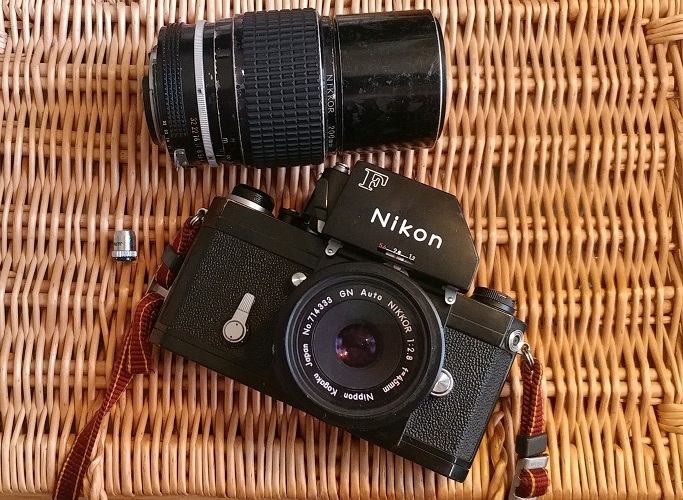
The OM system came with a ton of options like winders and data backs. Today availability is spotty but parts are still circulating at reasonable prices. One aspect I do wish Olympus brought was a detatchable prism for a waist-level finder, but that would've added to the cameras' diminutive size. As the system wasn't widely recognized by professional photographers relative to the Nikon F series, hype is low. While F2's and FM2's easily exceed $150 in 2020, I picked up this OM-2 for less than $50. The comparatively sparse lenses are around the same price as Nikon/Canon, with exceptions like the mythical 40mm f2 pancake lens and 100mm f2. The OM-4ti too, being the last iteration in the OM series before Olympus' complete transition into digital, still commands high prices. As it was only discontinued in 2002 with an MSRP of $1200, bodies regularly sell for around $200. Still pennies compared to the change vaccum that is digital cameras.

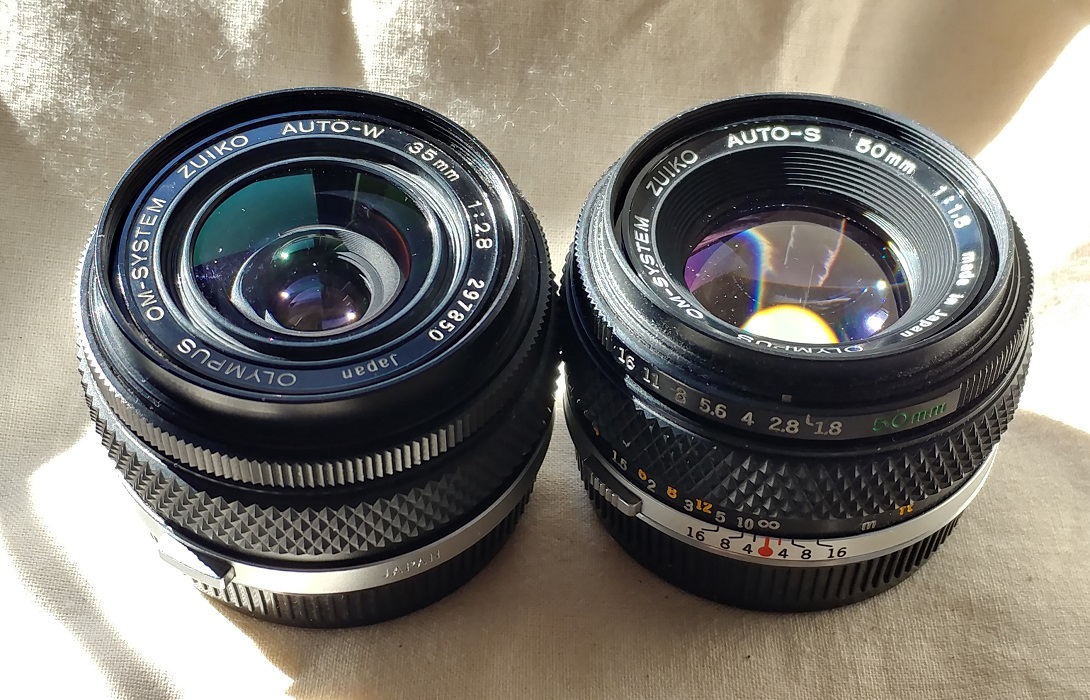 50mm f1.8, 35mm f2.8 size comparison (w/ rear lens caps)
50mm f1.8, 35mm f2.8 size comparison (w/ rear lens caps)
With every vintage camera there's going to be a host of well-documented mechanical issues that loom over like susceptible diseases. The baggage of the OM system isn't too bad, but there are a few. The OM-1, being made for discontinued mercury cell batteries, needs some tweaking for accurate metering. Early OM-1/2/1n/2n's have prism foam that can degrade and eat away your viewfinder coverage.
Handling
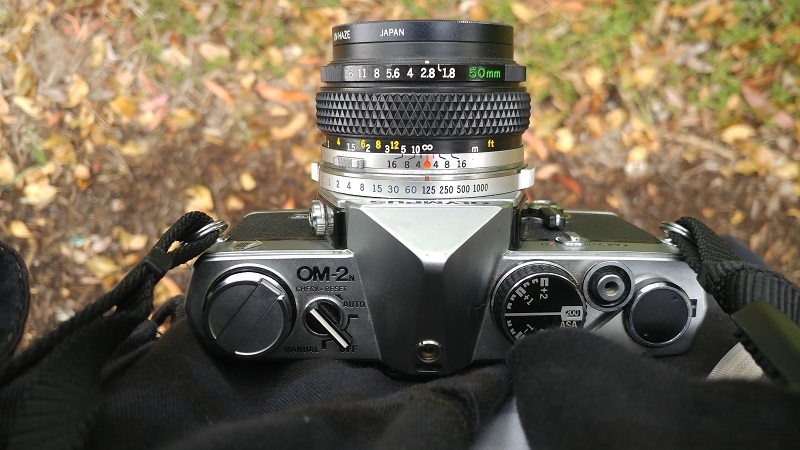
It's bretty gud in the hands. Height comparable to my Konica C35, weight actually less than my Electro 35. Even relative to later plastic-bodied EOS cameras the OM-2 is still lighter. It's tiny and light. I opted to take the hot shoe off for now, and that's a really nice option to have. The OM series has its controls layout on the collar of the lens mount and on the detachable lens itself. Aperture at front, focus in the middle, shutter speed on the collar. Everything is centralized and legible. The aperture being at the front bothered me initially, but it makes a lot of sense in aperture priority mode. Compared to the OM-10 the mirror slap is definitely minimized. I'm really interested in the auto winder, even if the added bulk is antithetical to the OM system theology.


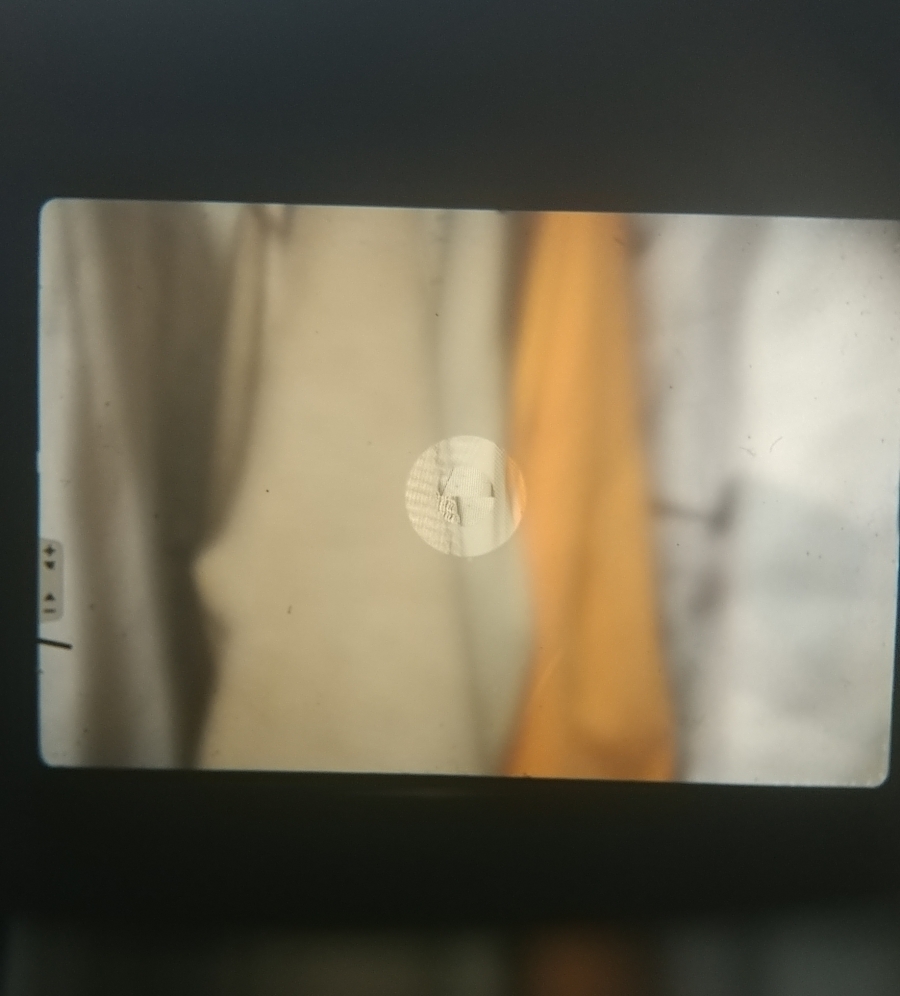
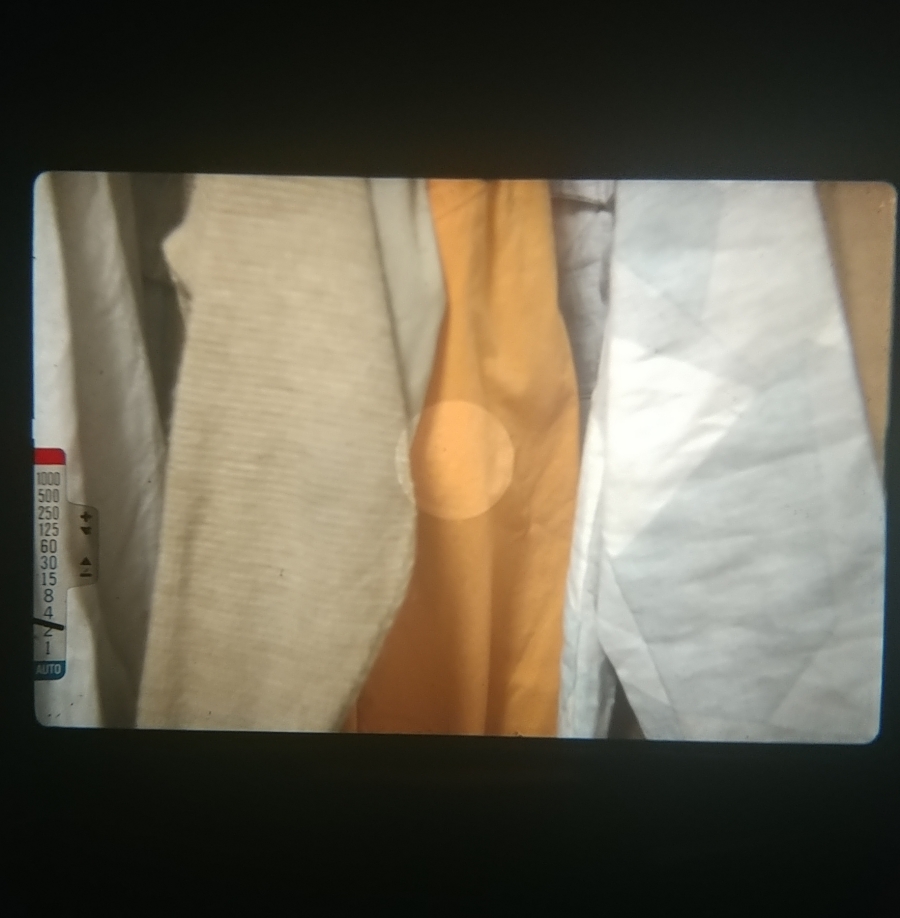
The viewfinder is spartan but wonderfully bright. Manual mode shows an indicator to the left of the viewfinder with over/underexposure marks segmented by stops. Center the needle in the middle by fiddling with your aperture/shutter speed, and you have a perfect exposure. You can clearly see the split ring focusing centered in the first picture, and the blurry mess alludes that you're not in focus. Aperture priority introduces a shutter speed gradation instead. I think I still prefer an LED indicator that's on the cheaper OM-10 at night, and as it's not a physical object moving should be more reliable. Shame that there's no inputs inside the viewfinger regarding your shutter/aperture like the X700. Does the OM-2n's dependence on batteries get to me? Right now, not at all. The option of aperture priority is a huge plus, too. But we'll see if my opinion on that shifts as I use this thing more. Also replacing light seals on this thing are a pain. Exceptional pain.
Overall, a very fast and convenient little SLR. It's a camera I can hand over to people when out drinking and they'll need no explanation on how to focus.
Performance
Fuck me dead this thing is easy to use. Controls are laid out well, viewfinder is giant. While I can't say the split focusing is faster than a rangefinder, the depth of field is a very useful indicator. Once complaint is that the light meter is a bit hard to see when shooting portraits or at low-light scenes. Portability is impressive, but ultimately it's still an SLR. Lack of a shutter release lock is odd, but not a huge deal considering it's shrouded.
Aperture priority with the shutter speed readouts in the viewfinder is fantastic. Load some 800 speed film, have a 35mm lens on f/8, set to aperture priority, and you have what is essentially a point-and-shoot camera.
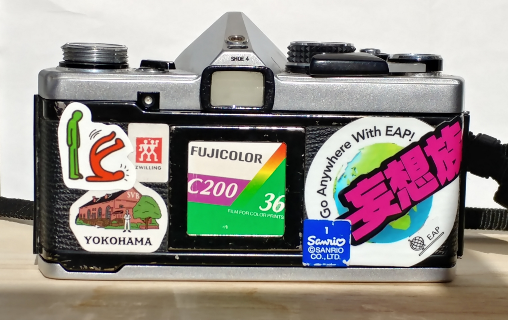 A sticker for every meaningful event, interchangable backs make this reversible and easy.
A sticker for every meaningful event, interchangable backs make this reversible and easy.
Conclusion 12/3/2019
The C35 died and I sold the Electro, which left this camera as my main for the better part of 5 rolls. It's been a fairly average and even monotonous experience. The shooting experience is concise, the viewfinder is massive. I've been utterly spoiled with its dimensions relative to similar SLR's like the A-1 and F2. The only downsides are the pricy lenses relatve to Pentax and Minolta (but comparable to Nikon/Canon) and the gritty film advance. I don't dislike the OM-2n, but I think taking a break will get me to truly appreciate what it is. 12/21/2019
It is a very arousing camera though, everything just looks right. Even the technically superior OM-4 doesn't have the cohesion that the OM-2 does. 1/1/2020
god I wish the aperture ring had an arm like some rangefinders. It would be perfect to be able to comfortably adjust the shutter speed with your right hand while messing with aperture and focus with your left hand.
4/15/2019
I find myself using the original 50mm lens more than the 35 I just got. I really love this camera, it hits all the right buttons for me. If the viewfinder had both aperture/shutter speed readouts and the film advance was a bit smoother, this would be the camera for me.
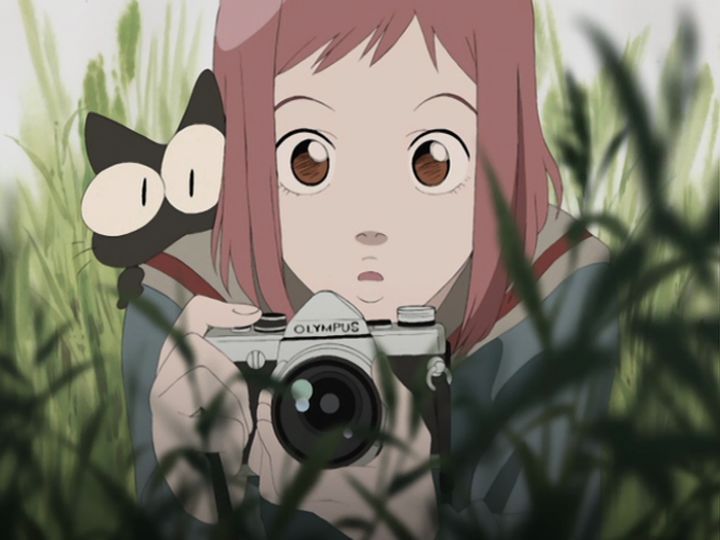 back to top ⤴
back to top ⤴
